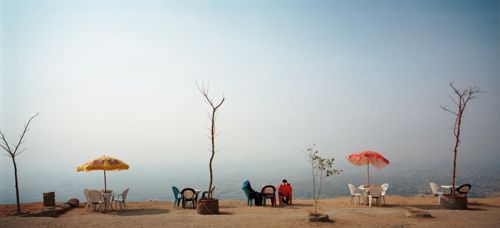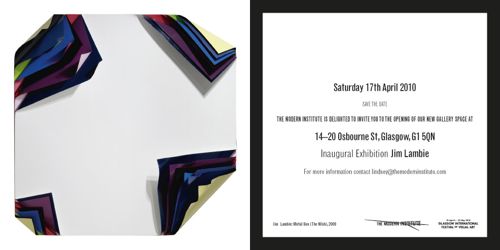
Month: February 2010
Amir Zaki

Perry Rubenstein Gallery is pleased to announce Amir Zaki, Relics, a new body of photographic “portraits” of elevated lifeguard towers taken along different beaches in Southern California. The exhibition represents a continuation in the artist’s ongoing interest in architectural structures, but marks a distinct shift in terms of location—from urban Los Angeles to the beaches south of the city. Amir Zaki Relics will be on view from May 6 through June 15, 2010.
With the new series, the artist’s intention is to create photographs that transform seemingly banal lifeguard towers that dot the Pacific beaches of Orange County into something other. They appear as awkward monumental public sculptures or stylized and non-functioning relics. The images of the lifeguard towers function less as a typology, but rather anthropomorphized as a group of portraits, not only because they resemble heads resting on necks, but also because the individual character of each tower is emphasized in a very specific way. Each of the images of the lifeguard towers are photographed against a sky, shot from below, and never include any trace of sand or ocean. Because they are isolated from any reference to locale, they sometimes appear to be other than what they actually are.
Zaki has digitally altered the images in a variety of ways ranging from simple color changes to gravity defying, physically improbable structural modifications. He has digitally removed any visible access routes such as ladders or ramps leading to the tower platforms. This appears as a subtle subtraction, but renders the towers essentially dysfunctional. The artist has pared down the visual information in this work to two fundamental elements, which are the tower and the sky (subject and background). Many of the towers have been paired with skies photographed on a different day, with rather incongruous lighting.
Also to be included in the exhibition are a group of images depicting the iconic ‘beach mobile’, the Volkswagen Vanagon. The Vanagon images have manifested in a photographic diptych and a triad of abstract mandala-like patterns. The Vanagon is essentially a slightly glorified box, an elongated cube designed to be able to fit the maximum amount of fun-based cargo, with little regard for luxury. It represents summer day trips, leisure, camping, surfing, and a bygone era of automobile design that emphasized form following a maximum use of space, as opposed to concerns with ergonomics, aerodynamics, or electronic gear. In that sense, like the transformed lifeguard tower, it is a relic.
The photographic diptych of the Vanagon is presented as a Yin-Yang duality between sunrise and sunset, moonrise and moonset. How one decides which is which depends on whether one believes the images depict a ‘west’ coast or ‘east’ coast. The Vanagons face each other, as polar opposites (solar/lunar/dawn/dusk) but simultaneously equivalent and interchangeable. This duality is directly based upon the color scheme of two Volkswagen Vanagon models from 1982. One is a cool, two-tone blue/light-blue (representing dawn) with a full moon and daybreak-pink- purple sky above, and the other a warm, two-tone orange/cream (representing dusk) with a full sun and yellow-orange sunset sky above.
Despite all of these apparent polar opposites or dualities, in actuality Zaki made the two original photographic exposures just a few minutes apart during one mid- morning under an overcast sky, using only one Vanagon. The ‘other’ Vanagon was created digitally by altering the color palette of the auto paint. The dramatic cliché skies were completely concocted using multiple photographs of skies, moons and suns. Now as a pair, the Vanagons are idealized, nearly all of the hardware and blemishes digitally erased.
Both the images of lifeguard towers and of Vanagons share a fascination with the familiar made unfamiliar, by creating abnormal looking structures/objects as portraits.
Amir Zaki has exhibited internationally since 1996. His work is included in the following public collections: Henry Art Gallery, Seattle; New Museum of Contemporary Art, New York; Orange County Museum of Art, Newport Beach, CA; and, the Whitney Museum of American Art, New York, among others. Relics marks the artist’s third exhibition with Perry Rubenstein Gallery.
KAWS
For the Sake of the Image

For the Sake of the Image investigates the reciprocal relationship between moving image and sound, considering sound not merely as an accompaniment to the moving image but exploring how the force of one multiplies the power of the other.
Featuring the work of emerging artists Asnat Austerlitz, Richard Bevan, Juan Fontanive, Paul O’Kane, Mark Raidpere and Dan Walwin as well as exhibition curator, Suki Chan , this exhibition is the next in the Jerwood Visual Arts Encounters series.
“The use of sound defines space. It constructs places and narratives that are not necessarily seen. Combined with moving images, sound initiates a particular kind of encounter between the audience and the artwork. From the use of emotive sounds that assist to transport the viewer to a personal space, to incidental sounds which grounds the experience, sound exposes the physicality of the medium or the framework in which the artwork is presented.”
Suki Chan, Curator, For the Sake of the Image
This exhibition is an enquiry into the relationship between image and sound and includes artists chosen for their personal and diverse approach to the subject. For the Sake of the Image features a broad range of work, including some previously unseen. These range from works created in conventional ways with simultaneously recorded footage and soundtracks, to those where the sound is composed and added retrospectively. These will be shown alongside more unconventional approaches to the definition of moving image work; works which play with pure image, silence, incidental sounds and kinetic movement.
For the Sake of the Image is Suki Chan’s first exhibition as a curator. Her recent solo shows include Sleep Walk Sleep Talk, a major video installation commissioned by Film and Video Umbrella in 2009, and Interval II, commissioned by the Chinese Arts Centre in 2008. She has been included in several group shows in the UK, including in Repetition & Sequence at Jerwood Space in 2006. Most recently, Suki was selected as one of six young British artists by Charles Saatchi to take part in the BBC’s School of Saatchi. Suki graduated with BA (Hons) from Goldsmiths in 1999 and completed an MA in Fine Art at Chelsea School of Art in 2008.
For the Sake of the Image demonstrates the Jerwood Charitable Foundation’s commitment to supporting moving image within the Jerwood Visual Arts programme.
Asnat Austerlitz graduated with an MFA from the Slade School of Fine Art, UCL in 2004 and lives and works in Israel. Her work explores ideas of space, time and place and has been exhibited in the UK, Israel, Sweden and Japan. Her practice takes the forms of drawing, video, photography, screenprint and sculpture.
Richard Bevan graduated in 2008 with an MA Fine Art Media from Slade School of Fine Art (UCL), London. His work deals with the tension between film as a medium and light as its agent.
Juan Fontanive is based in New York and graduated in 2006 with an M.F.A. from The Royal College of Art, London. His interest lies in the beauty of sequential and repetitive movement. Not a conventional filmmaker or video artist, his hand drawn characters move across the frame of ‘paper films’ to the rhythm of clockwork mechanisms.
Paul O’Kane recently completed a PhD in History of Ideas at University of London on ‘Hesitation’ and is a Londonbased artist, writer, tutor and musician. Working across numerous disciplines simultaneously he investigates and consolidates principles of art and thought as illuminated via various filters, differences and juxtapositions.
Mark Raidpere is a young Estonian artist who studied film studies at Tallinn Pedagogical University (2000-2003). He is established and well represented in his practice yet has rarely shown in the UK. Mark has shown a consistent search of the dynamic relationship between the evolution of selfidentity and social events in the time of postcold war transition. His work, utilising video as the main medium, explores the psychological states of those living in our time of radical social change.
Dan Walwin graduated in 2007 with BA Hons Fine Art from Goldsmiths College, London. His video works to date explore the creation of cinematic scenarios, while examining the construction of mood and tension in cinema, and establishing connections between the context and surroundings in which a work is shown and the work itself.
Copenhagen Graffiti
Jim Lambie / The Modern Institute
ERIK SCHMIDT
ARMIN LINKE

The images in Armin Linke’s solo exhibition at the Heidelberger Kunstverein stem from such widespread places like Algeria, South Korea, Brazil, Uzbekistan, Italy, Mexico and Switzerland. In the main space of the Kunstverein the exhibition presents select images from the astounding photographic archive, that includes more than 100.000 images. From 1999 and onwards the archive has documented the globalized world with images from Pjöngjang to Genova, all composed in the same unagitated but precise and understated manner.
Alongside the framed prints a digital version of the entire archive, which is designed by Alex Rich and Peter Hanappe will be on display. With a recently completed software the viewer can select images for an individual print-on-demand book. Armin Linke was born in Milano, lives in Berlin, teaches in Karlsruhe and exhibits worldwide.








